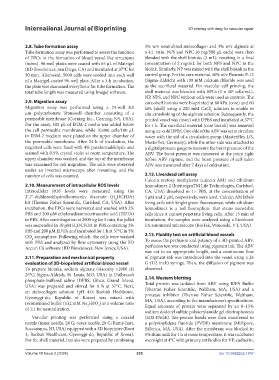Page 343 - IJB-10-2
P. 343
International Journal of Bioprinting 3D printing with drug for vascular repair
2.8. Tube formation assay 3% w/v neutralized atelocollagen and 3% w/v alginate at
Tube formation assay was performed to assess the function a 4:1 ratio. NPS and NPC (6 mg/500 μL each) were then
of EPCs in the formation of blood vessel-like structures blended with the shell bioinks (3 mL), resulting in a final
(tubes). 96-well plates were coated with 65 μL of Matrigel concentration of 2 mg/mL for both NPS and NPC in the
(BD Biosciences, San Diego, CA) and incubated at 37°C for bioink. Similarly, NP was mixed with the shell bioink as the
30 min. Afterward, 5000 cells were seeded into each well control group. For the core material, 40% w/v Pluronic F-12
of a Matrigel-coated 96-well plate. After a 3-h incubation, (Sigma-Aldrich) with 100 mM calcium chloride was used
the plate was examined every hour for tube formation. The as the sacrificial material. For vascular cell printing, the
6
total tube length was measured using ImageJ software. shell material was blended with EPCs (1 × 10 cells/mL).
NP, NPS, and NPC without cells were used as controls. The
2.9. Migration assay core-shell bioinks were bioprinted at 80 kPa (core) and 60
Migration assay was performed using a 24-well 8.0 kPa (shell) using a 200 mM CaCl solution to enable in
2
μm polycarbonate Transwell chamber consisting of a situ crosslinking of the alginate solution. Subsequently, the
permeable membrane (Corning Inc., Corning, NY, USA). printed vessel was rinsed with DPBS and incubated at 37°C
For the assay, 500 μL of EGM-2 media was added below for 1 h. The sacrificial material (core bioink) was removed
the cell permeable membrane, while 10,000 cells/100 μL using ice-cold DPBS. One side of the ABV was set to circulate
in EBM-2 medium were plated on the upper chamber of water with the aid of a circulation pump (MasterFlex L/S,
the permeable membrane. After 24 h of incubation, the Masterflex, Germany), while the other side was attached to
migrated cells were fixed with 4% paraformaldehyde and a digital pressure gauge to measure the burst pressure of the
stained with 0.5% crystal violet at room temperature. The ABV. The burst pressure was measured at the point right
upper chamber was washed, and the top of the membrane before ABV rupture, and the burst pressure of cell-laden
was examined for cell migration. The cells were observed ABV was measured after 7 days of cultivation.
under an inverted microscope after mounting, and the
number of cells was counted. 2.12. Live/dead cell assay
Calcein acetoxy methylester (calcein AM) and ethidium
2.10. Measurement of intracellular ROS levels homodimer-2 (InvitrogenTM Life Technologies, Carlsbad,
Intracellular ROS levels were measured using the CA, USA) dissolved in 1× PBS, at the concentration of
2′,7′-dichlorodihydrofluorescein diacetate (H DCFDA) 4 μM and 2 μM, respectively, were used. Calcein AM labels
2
kit (Thermo Fisher Scientific, Carlsbad, CA, USA). After living cells with bright green fluorescence, while ethidium
incubation, the EPCs were harvested and washed with 2% homodimer is a red fluorophore that stains nonviable
FBS and 200 µM ethylenediaminetetraacetic acid (EDTA) cells since it cannot penetrate living cells. After 15 min of
in PBS. After centrifugation at 2000 ×g for 3 min, the pellet incubation, the samples were analyzed using a Lionheart
was suspended in 10 μM H DCFDA in PBS containing 2% FX automated microscope (BioTek, Winooski, VT, USA).
2
FBS and 200 μM EDTA and incubated for 1 h at 37°C in 5%
CO atmosphere. Following which, the cells were washed 2.13. Fluidity test on artificial blood vessels
2
with PBS and analyzed by flow cytometry using the BD To assess the perfusion and patency of a 3D-printed ABV,
Accuri C6 software (BD Biosciences, New Jersey, USA). perfusion test was conducted using pigment ink. The ABV
was cut to an appropriate length, and a continuous flow
2.11. Preparation and mechanical property of pigment ink was introduced into the vessel using a 26
evaluation of 3D-bioprinted artificial blood vessel G (1/2 inch) syringe. Then, the diffusion of pigment was
To prepare bioinks, sodium alginate (viscosity >2000 cP, observed.
25°C; Sigma-Aldrich, St. Louis, MO, USA) in Dulbecco’s
phosphate-buffered saline (DPBS, Gibco, Grand Island, 2.14. Western blotting
USA) was prepared and stirred for 6 h at 37°C. Next, Total protein was isolated from ABV using RIPA Buffer
an atelocollagen solution (pH 4.0; Baobab Healthcare, (Thermo Fisher Scientific, Waltham, MA, USA) and a
Gyeonggi-do, Republic of Korea) was mixed with protease inhibitor (Thermo Fisher Scientific, Waltham,
MA, USA), according to the manufacturer’s specifications.
reconstituted buffer (132 mM Na HPO ) at a volume ratio Equal amounts of protein were separated by an 8–15%
4
2
of 1:1 for neutralization.
sodium dodecyl sulfate polyacrylamide gel electrophoresis
Vascular printing was performed using a coaxial (SDS-PAGE). The protein bands were then transferred to
nozzle (inner needle, 28 G; outer needle, 20 G; Ramé-hart, a polyvinylidene fluoride (PVDF) membrane (Millipore,
Succasunna, NJ, USA) equipped with a 3D bioprinter (Root Billerica, MA, USA). After the membrane was blocked in
1; Baobab Healthcare, Gyeonggi-do, Republic of Korea). 5% skim milk for 1 h at room temperature, it was incubated
For the shell material, bioinks were prepared by combining overnight at 4°C with primary antibodies for VE-cadherin,
Volume 10 Issue 2 (2024) 335 doi: 10.36922/ijb.1857

